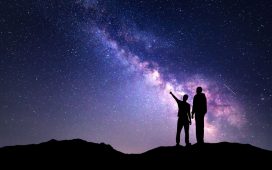Nasa’s James Webb space telescope has revealed a planet where specks of sand fall as rain, in groundbreaking observations.
The planet, Wasp-107b, lies 200 light years away in the Virgo constellation and had already caught the attention of astronomers because it is very large but very light, earning it the nickname the “candy floss” planet. The latest observations give an unprecedented glimpse of a strange and exotic world beyond our solar system that features silicate sand clouds and rain, scorching temperatures, raging winds and the distinct burnt-matches scent of sulphur dioxide.
“Our knowledge of other planets is based on what we know from Earth,” said Prof Leen Decin, of the Catholic Institute (KU) Leuven and first author of the research. “That’s a very restricted knowledge.”
The planet was discovered in 2017 after astronomers spotted a telltale periodic flickering of light from its host star each time the planet passed in front of it. “It’s like a fly in front of a street lamp,” said Decin. “You see a slight dimming of the light.”
James Webb takes these observations to the next level by measuring starlight that is filtered through the planet’s atmosphere. Because different elements absorb different wavelengths of light, the spectrum of starlight indicates which gases are present.
Wasp-107b is similar in mass to Neptune but almost the size of Jupiter, and its vast, diffuse nature allows the James Webb telescope to peer deep into its atmosphere.
“It’s a great target because it’s really fluffy. It’s one of the fluffiest planets out there and they’re the ones we can get these big signals when we look at their atmosphere,” said Dr Joanna Barstow, a planetary scientist at Open University who is working on separate JWST measurements of the same planet. “We’ve been working on predictions for the past 10 years but nothing has quite prepared us for what we’re actually seeing – both what we’re finding out and the quality of the data. It’s been really exciting.”
The latest observations, published in Nature, reveal evidence of water vapour and sulphur dioxide, which would give the atmosphere a smell of burnt matches. It is also the first time the chemical composition of clouds on another planet has been identified – in this case, silicate sand.
The planet’s atmosphere would feature something akin to Earth’s water cycle, but instead with sand cycling between solid and gaseous states. From the hotter, lower levels of the atmosphere, with temperatures close to 1,000C, silicate vapour would rise up, cool and form microscopic grains of sand, too small to see. Eventually, these clouds of sand dust would become dense enough that they begin to rain back down to the lower layers of the atmosphere. Below a certain level, the sand would sublime back into vapour, completing the cycle.
“The clouds would be like a hazy dust,” said Decin. “And these sand particles are streaming around at extremely high velocity. A few kilometres per second.”
A central aim of the James Webb space telescope is to analyse the atmospheres of distant planets and search for biosignature gases that could indicate the presence of life. Wasp-107b is not regarded as a likely candidate, given its 1,000C climate and lack of a solid surface. “It’s absolutely hostile – not for us,” said Decin.
Observations of the atmospheres of rocky Earth-sized planets will be more challenging because, if they have an atmosphere, it tends to be thinner and denser. However, the level of detail being obtained from targets like Wasp-107b is seen as an encouraging sign.
“The universe has so many surprises,” said Decin. “I do envision that there may be various alternative ways for life to form on another planet. It might be very different from something you know here on Earth. We have to broaden our imaginations.”










